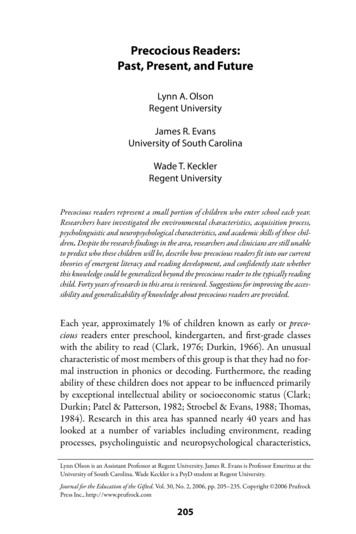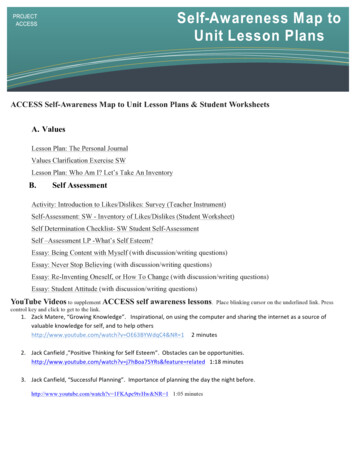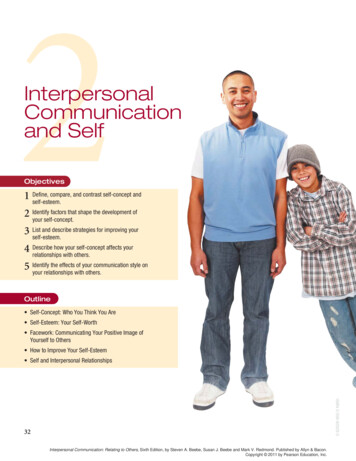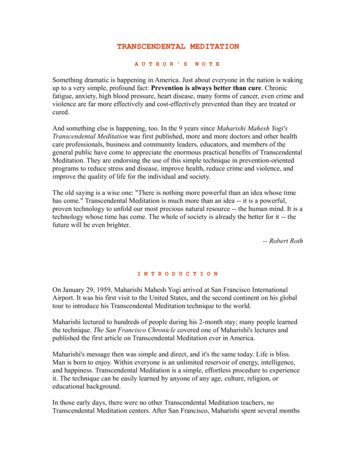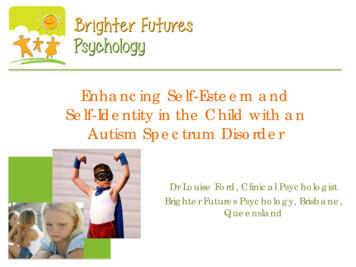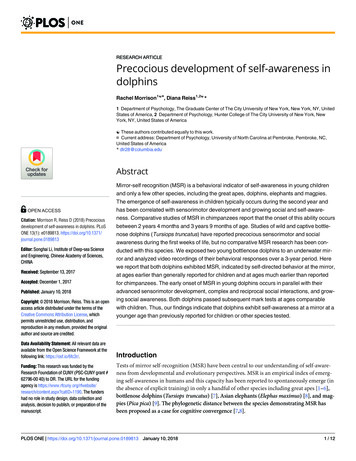
Transcription
RESEARCH ARTICLEPrecocious development of self-awareness indolphinsRachel Morrison1 , Diana Reiss1,2 *1 Department of Psychology, The Graduate Center of The City University of New York, New York, NY, UnitedStates of America, 2 Department of Psychology, Hunter College of The City University of New York, NewYork, NY, United States of 1a1111111111OPEN ACCESSCitation: Morrison R, Reiss D (2018) Precociousdevelopment of self-awareness in dolphins. PLoSONE 13(1): e0189813. : Songhai Li, Institute of Deep-sea Scienceand Engineering, Chinese Academy of Sciences,CHINAReceived: September 13, 2017Accepted: December 1, 2017Published: January 10, 2018Copyright: 2018 Morrison, Reiss. This is an openaccess article distributed under the terms of theCreative Commons Attribution License, whichpermits unrestricted use, distribution, andreproduction in any medium, provided the originalauthor and source are credited. These authors contributed equally to this work. Current address: Department of Psychology, University of North Carolina at Pembroke, Pembroke, NC,United States of America* dlr28@columbia.eduAbstractMirror-self recognition (MSR) is a behavioral indicator of self-awareness in young childrenand only a few other species, including the great apes, dolphins, elephants and magpies.The emergence of self-awareness in children typically occurs during the second year andhas been correlated with sensorimotor development and growing social and self-awareness. Comparative studies of MSR in chimpanzees report that the onset of this ability occursbetween 2 years 4 months and 3 years 9 months of age. Studies of wild and captive bottlenose dolphins (Tursiops truncatus) have reported precocious sensorimotor and socialawareness during the first weeks of life, but no comparative MSR research has been conducted with this species. We exposed two young bottlenose dolphins to an underwater mirror and analyzed video recordings of their behavioral responses over a 3-year period. Herewe report that both dolphins exhibited MSR, indicated by self-directed behavior at the mirror,at ages earlier than generally reported for children and at ages much earlier than reportedfor chimpanzees. The early onset of MSR in young dolphins occurs in parallel with theiradvanced sensorimotor development, complex and reciprocal social interactions, and growing social awareness. Both dolphins passed subsequent mark tests at ages comparablewith children. Thus, our findings indicate that dolphins exhibit self-awareness at a mirror at ayounger age than previously reported for children or other species tested.Data Availability Statement: All relevant data areavailable from the Open Science Framework at thefollowing link: https://osf.io/6fc3r/.IntroductionFunding: This research was funded by theResearch Foundation of CUNY (PSC-CUNY grant #62796-00 40) to DR. The URL for the fundingagency is aspx?catID 1190. The fundershad no role in study design, data collection andanalysis, decision to publish, or preparation of themanuscript.Tests of mirror self-recognition (MSR) have been central to our understanding of self-awareness from developmental and evolutionary perspectives. MSR is an empirical index of emerging self-awareness in humans and this capacity has been reported to spontaneously emerge (inthe absence of explicit training) in only a handful of other species including great apes [1–6],bottlenose dolphins (Tursiops truncatus) [7], Asian elephants (Elephas maximus) [8], and magpies (Pica pica) [9]. The phylogenetic distance between the species demonstrating MSR hasbeen proposed as a case for cognitive convergence [7,8].PLOS ONE https://doi.org/10.1371/journal.pone.0189813 January 10, 20181 / 12
Development self-awareness dolphinsCompeting interests: The authors have declaredthat no competing interests exist.The general paradigm used to evaluate the capacity for MSR in humans and other animalsinvolves documenting the behavioral responses of individuals during mirror exposure. Striking behavioral similarities have been reported across species showing MSR. Individuals generally progress through three basic stages: 1) mirror exploration or social behavior, 2)contingency-testing (i.e., performance of unusual & repetitive behaviors at the mirror affording the opportunity to perceive a one-to-one correspondence between the individual’s behavior & the mirror image), and 3) self-directed behavior (i.e., viewing body parts/behaviorsunobservable in the mirror’s absence) [2,7,8,10,11]. In prior MSR studies, self-directed behavior has been considered a critical indicator of MSR [12] and the mark test [2], or rouge testwith children [11], has been implemented after individuals exhibit self-directed behavior tofurther confirm this ability. During the mark test, an individual is marked on an area of theface or body that is only visible to them in a mirror. The standard criteria for passing the marktest requires that after being marked, an individual then touches, investigates, or in the case ofthe non-handed dolphin, orients the marked area to the mirror.Developmental studies with children have reported that MSR, as evidenced by self-directedbehavior, first emerges between 12–15 months and mark-directed behavior (passing the marktest) emerges between 18–24 months [10,11,13]. The emergence of MSR in children coincideswith the onset of other indices of self and social awareness (e.g. pretend play [14] empathy andprosocial behavior [1,15,16], synchronic imitation [14,15] and may be linked to the development of sensorimotor intelligence [4,10]. Theories regarding the developing process of selfawareness in children have also proposed proprioceptive awareness as a landmark antecedentfor the perception of self in a mirror [17,18]. Comparative studies with chimpanzees, reportthe earliest age for self-directed behavior from 24 months [13,19] to 3 years 3 months [4] andfor mark-directed behavior from 2 years 4 months [13,19] to 3 years 9 months [4] (age discrepancies may be due to different criteria for self-directed behavior and passing the mark test[4,13,19]).MSR was previously demonstrated in two adult male dolphins [7] but no comparativedevelopmental studies of MSR have been conducted with young dolphins. Studies of wild andcaptive bottlenose dolphins have reported precocious sensorimotor and social development inthis species. Within the first postpartum weeks, dolphin calves show advanced sensorimotorand muscle development as well as complex and reciprocal social interactions [20–26]. Studieshave reported precocious locomotor muscle development in newborn calves similar to that ofadult dolphins [20] and it has been reported that by one month of age, dolphins show earlydevelopment of proprioception leading to advanced motor coordination [21]. Social awarenessin calves increases in the postpartum weeks as they synchronize their swimming and breathingwith their mother’s and recognize and reunite with them after separations [23]. Compared toinfant human and nonhuman primates, dolphin calves engage with other members of theirsocial group at a younger age. By the end of the first postpartum week, calves in the wildengage in social play behaviors with individuals other than their mothers [23] and observationsconducted from birth through the 4th year report that the number of associations with different individuals peaks during the first year of development [24]. The early development ofsocial and other cognitive skills in dolphin calves, as in the case for humans, may contribute tothe ability for MSR. Cognitive research conducted with young captive dolphins demonstratedthat by the end of their first year they show a proclivity for spontaneous vocal and associativelearning [26], skills that may contribute to the awareness of self and others.Given the comparatively precocious development of social awareness and sensorimotorskills observed in dolphins and the reported relationship between these domains and the development of MSR in humans, we investigated whether the emergence of MSR in dolphins woulddevelop at a comparatively young age. We exposed two young bottlenose dolphins within theirPLOS ONE https://doi.org/10.1371/journal.pone.0189813 January 10, 20182 / 12
Development self-awareness dolphinssocial group to a mirror during a 3-year longitudinal study. We followed a similar methodology for mirror exposure as employed by Reiss and Marino [7] in their study on MSR indolphins.MethodsSubjects and proceduresTwo captive born young bottlenose dolphins, Bayley (female, age 3.5 months) and Foster(male, age 14 months), were exposed to a one-way mirror with their social group of sevenother bottlenose dolphins housed at the National Aquarium in Baltimore, MD. Sessions wereconducted during a period from November 21, 2008 through December 15, 2011 for 1 hour1–2 days biweekly at 9 am, prior to the dolphin area being open to the public. On occasion,due to scheduling issues, some sessions were conducted in the late morning, were less than 1hour in duration, or were not conducted. Each dolphin’s behavior was videotaped in all threeconditions: baseline (mirror absent), mirror (mirror present) or control (a one inch wide nonreflective frame affixed to inside of window). Baseline and control sessions were interspersedbetween experimental/mirror sessions. All sessions were conducted from an underwater viewing window on the wall of a 4 ft. in diameter circular observation room that was accessiblefrom above via a horizontal ladder and could be completely enclosed and darkened by closinga hatch door. The observation room is located between 3 interconnected pools (EP, the mainexhibit pool; HP1 & HP2, two holding pools). Within the observation room, there are threewindows, one into each of the pools. The observation room and the HP1 & HP2 holding poolscan be accessed only by staff and research personnel. During experimental sessions, the dolphins were exposed to and tested with the mirror when they were in HP1. The number of dolphins present in the pool displaying the mirror during experimental sessions varied over thecourse of the study due to husbandry decisions based on the social dynamics. Thus, the dolphins were not always exposed to the mirror within the same session or with the same members of their social group. The dolphins were not housed alone and therefore individuals werenot exposed to the mirror when alone.These dolphins were not considered to be mirror naïve at the onset of the study becausethey had prior exposure to potentially semi-reflective windows on the walls of their pools. Themain dolphin pool (EP) has large expanses of windows around the perimeter and the HP1 andHP2 pools each had one smaller observation window as previously described. The dolphinexhibit is illuminated from above by windows; the natural daylight creates differential andchanging light levels that can result in the windows having mirror-like reflectivity.Mirror sessionsWe affixed a one-way mirror (23 W x 35 H) to the outside of an underwater viewing window, which presented a reflective mirror surface to the dolphin side of the pool and a transparent surface as seen from the inside of the observation area. This enabled us to videotape all ofthe dolphins’ responses to the mirror. To create an optimal one-way mirror, it was necessaryto completely darken the non-mirror side in the observation room by covering the remainingtwo windows with dark velour curtains. The authors and a member of the dolphin care staffobserved from seated positions in the observation room and took notes on the identity of thedolphins at the mirror, the time of their arrival at the mirror, and their subsequent behavior.Neither the camera nor the researchers were visible to the dolphins. The researchers weresilent during the sessions.PLOS ONE https://doi.org/10.1371/journal.pone.0189813 January 10, 20183 / 12
Development self-awareness dolphinsMark test sessionsFollowing the paradigm used in a previous study reporting MSR in adult dolphins [7], multiplemark tests were conducted with each dolphin after self-directed behaviors were well-documented. During mark test sessions, the dolphins were exposed to the mirror for approximately15-minutes. The researchers then notified the trainers to approach the pool and signal the dolphins to station at the opposite side of the pool from the mirror. Using either a black ink nontoxic temporary marker (Entre Marker, Westborough, MA) or black lipstick (NK, with Vitamin E, No 306, 014729F10), a single dolphin was marked with a triangular or X-shaped mark(area 6. 4 cm) by their trainers on various parts of their body that they could not see in theabsence of the mirror. Specifically, the dolphins were marked on either side of their headbehind their eye, on the palmar side of one of their pectoral fins, or on their ventral surfacebetween their pectoral fins. After the mark was applied, the marked dolphin and other dolphins were released from station and video recordings continued to document the dolphins’behaviors at the mirror. During these sessions, the researchers in the observation room documented the time of stationing (when the dolphin was marked), the time of release from stationing, the time of the marked dolphin’s first arrival at the mirror in the post-mark condition,and their subsequent behavior at the mirror. Due to husbandry concerns, the initial mark testswith both dolphins were delayed until they were at least 2 years old (Foster: 2 years, 2 months;Bayley: 2 years, 7 months). Also, to minimize the marking and handling of these young animals, we did not conduct sham marks prior to marking as described in Reiss and Marino [7].Baseline sessionsBaseline sessions were conducted to determine the dolphins’ behaviors at the window in theabsence of the mirror. These sessions were videotaped in the same manner as the experimentalsessions, however, in order to minimize the reflective properties of the window itself, the interior of the observation room was not darkened; in baseline conditions the windows remaineduncovered and the hatch above was open. Because the dolphins could see into the observationroom through the window, the video camera was started and the researchers immediately leftthe area until the termination of the session.Control sessionsTo control for the placement of a novel object (the mirror) onto the window, a non-reflectiveclear surface (Plexiglas) was affixed to the window and video recordings were conducted. After3 sessions, it was determined that the Plexiglas itself was reflective when mounted against thewindow surface and we discontinued its use. Instead, we used a 1-inch-wide non-reflectivematt black poster board frame with the same dimensions as the window for the control in theremaining control sessions. The protocol used for the baseline sessions was repeated in thecontrol sessions.Behavioral codingPrior to the beginning of the study, to determine the field of visibility at the mirror from thedolphins’ point of view, a diver wearing an underwater communication device positioned himself in front of the mirror, while the dolphins were held in adjacent pools. The diver’s reflectionwas videotaped from the observation room as he swam up to the mirror and oriented fromvarious positions and distances relative to the mirror. Simultaneously, the diver informed theresearchers in the observation room when he could and could not view different parts of hisbody in the mirror.PLOS ONE https://doi.org/10.1371/journal.pone.0189813 January 10, 20184 / 12
Development self-awareness dolphinsFor each dolphin, all sessions from year 1 and 1–2 mirror sessions per month for years 2and 3 were analyzed. The dolphins’ behaviors were analyzed using an ethogram, which wasbased on a previous ethogram developed by Reiss and Marino [7], but expanded to includeother behaviors, as well as specific codes for the dolphins’ body orientations and their distancesrelative to the mirror (S1 Table). In cases in which the dolphins exhibited a combination ofbehaviors at the same time (e.g. bubble production with inverted posture while moving headto the right and left), such composite behaviors were coded as one event. Using this systemthere was a high level of agreement between the observers; however, in cases in which therewas a disparity in coding, the observers reviewed the video together and recoded based ontheir agreement. Both authors independently reviewed and coded all mark test sessions and asubset of the sessions during the first year and one author (RM) analyzed the remainder of thesessions. Post independent analysis of the mark test sessions, the two observers discussed theirfindings and determined if they agreed. For each mark test session, we compared the dolphin’sbehavior in the pre-mark and post-mark condition to confirm that changes in the dolphin’sbehavior were in response to the presence of the mark. The dolphins passed the mark test ifthey oriented the marked part of their body toward the mirror more frequently in the postmark versus the pre-mark condition.The frequency of occurrence of specific behaviors exhibited by each dolphin were quantified and categorized as either exploratory/social behavior, contingency-testing, self-directed, stationing, or ambiguous. Stationing referred to the dolphin facing the mirror for 3 seconds, butnot engaged in a specific behavior. Some behaviors were difficult to classify; to be conservative,these behaviors (e.g. approach behaviors, rostrum contact with the mirror) were classified asambiguous. In early mirror sessions, repetitive behaviors first emerged and were typically classified as contingency-testing. In later sessions dolphins produced bouts of repetitive behaviorsin contexts when they were reliably exhibiting self-directed behaviors thus these repetitivebehaviors may be self-directed; however, to be conservative, all repetitive behaviors were categorized as contingency-testing. We also quantified the categories of behavior and the totaltime spent at the window in the baseline, mirror, and control conditions.Ethics statementThis study was approved by Hunter College’s Institutional Animal Care and Use Committee(IACUC) (Protocol #: DR dolphin MSR 1/13-02 Developmental aspects of MSR in dolphins)and the Animal Care Committee at the National Aquarium in Baltimore, MD.ResultsA total of 57 sessions were analyzed (baseline n 7, mirror n 44, & control n 6) (S2 Table).The dolphins produced similar behaviors described in prior MSR studies with humans[10,11,13], chimpanzees [2,4,13,27], and dolphins [7,28,29]. Throughout the study the predominant behavior exhibited at the mirror by both dolphins was self-directed (Table 1).Bayley exhibited only 8 (0.9%) instances of social behavior; most of her behavior was categorized as self-directed (f 356, 39.7%) (S1 Video), followed by ambiguous (f 242, 27%), stationing (f 201, 22.4%), and contingency-testing (f 90, 10%). Foster exhibited little socialbehavior (f 388, 9.3%); most of his behavior was categorized as self-directed (f 1926,46.2%) (S2 Video) followed by ambiguous (f 789, 18.9%), contingency-testing (f 664, 16%),and stationing (f 406, 9.7%)Social behavior directed toward the mirror was rarely exhibited by either dolphin, evenfrom the onset of mirror exposure. The low incidence of social and contingency-testing behaviors at the onset of the study may be due to the dolphins’ prior exposure to the semi-reflectivePLOS ONE https://doi.org/10.1371/journal.pone.0189813 January 10, 20185 / 12
Development self-awareness dolphinsTable 1. Frequency of categorized behaviors in the mirror, baseline, and control tingency-testing900166426Social80038801Numbers represent the frequency of each category of behavior for each of the 89813.t001properties of surfaces in their pools. On the first day of mirror exposure, Bayley (age 3.5months) spent little time at the mirror (46 sec); the few behaviors she exhibited (e.g. distantstationing, circling, & swimming by the mirror) were categorized as ambiguous (f 7, 100%).No social behaviors were observed on days 1, 2 or 3 (Fig 1A). On Bayley’s 4th day of mirrorexposure (age 5.5 months), we first observed instances of self-directed behavior. Although shespent only a few minutes at the mirror, when there, she exhibited predominantly self-directedbehavior (f 24, 53.3%) (e.g. close-eye viewing, bubble production in the absence of vocalization, body tilting) and few contingency-testing behaviors (f 3, 6.7%). In the following session,Bayley (age 6 months) continued to exhibit self-directed behavior in the absence of contingency-testing. By age 7 months, Bayley’s performance of self-directed behavior was well-established at the mirror. During Foster’s first day of mirror exposure (age 14.5 months), heexhibited predominantly self-directed behavior (f 48, 40.7%) marked by close eye viewing,open mouth viewing, and bubble production (in the absence of vocalization). Contingencytesting was also observed, but to a lesser degree (f 8, 6.8%); little social behavior (2 instancesof whistle bubble streaming and 2 instances of echolocation) was observed (f 4, 3.4%) (Fig1B).We quantified the categories of behavior and the total time spent at the window in the mirror, baseline, and control conditions. The dolphins produced more behaviors at the windowduring the mirror condition than during the baseline and control conditions (Table 1). Wealso compared the median duration of time (in seconds) each dolphin spent at the window inthe different conditions (Mann-Whitney U, Bonferroni corrected alpha 0.017). Both dolphins spent significantly more time at the window during the mirror condition: Bayley in mirror condition (Mdn 81.5), baseline condition (Mdn 0.0) (U 19.5, p .001, η2 .30), andcontrol condition (Mdn 0.0) (U 36.0, p .009, η2 .16); Foster in mirror condition(Mdn 427), baseline condition (Mdn 0.0) (U 3.0, p .001, η2 .40) and control condition (Mdn 25.5) (U 2.0, p .001, η2 .36). No significant difference was found betweendurations for baseline and control conditions for either dolphin: Bayley (U 18.0, p .60, η2 .02); Foster (U 7.5, p .05, η2 .32).A total of 12 mark tests were conducted (Foster n 9, Bayley n 3). Notably, both dolphinspassed their first mark test; Bayley passed 1 out of 3 mark tests and Foster passed 5 out of 9mark tests. In all positive mark tests, the dolphins oriented the marked area of their body tothe mirror and did so more often in the post-mark than the pre-mark condition (S3 Video,sequence 1 & 2; S4 Video, sequence 1). Mark tests were scored as ambiguous if the dolphinsoriented the marked part of their body to the mirror in the post-mark condition, but not significantly more than in the pre-mark condition. In 3 of the 9 mark tests conducted with Foster,the marker malfunctioned resulting in a partially visible or non-visible mark. We consideredPLOS ONE https://doi.org/10.1371/journal.pone.0189813 January 10, 20186 / 12
Development self-awareness dolphinsFig 1. Frequency of occurrence of categorized behaviors during each day of mirror exposure for eachdolphin. The shaded sections represent the age when children first demonstrate self-directed behavior (lightgray, 12–15 months) and mark-directed behavior (dark gray, 18–24 months). a, Although Bayley’s firstinstances of self-directed behavior at the mirror were observed at 5.5 months old (session 4), by 7 months old(session 9) her self-directed behavior was well established. b, Foster exhibited predominantly self-directedbehavior on his first day of mirror exposure when he was 14.5 3.g001these tests comparable to the late sham mark tests reported in Reiss & Marino [7]. In the latterand in our late sham-like tests, the dolphins had prior experience being marked and passed atleast one mark test. In both studies, the dolphins oriented to the sham-marked area. In two ofthese late sham-like conditions, Foster oriented more to the area sham-marked in the postmark condition than the pre-mark condition; therefore, these sham-like tests were consideredpassing mark tests. Bayley and Foster each failed 1 mark test because they did not approach themirror in the post-mark condition and this was scored as not at mirror (Table 2).Bayley passed the first mark test conducted when she was 2 years, 7 months of age. Afterbeing marked between her pectoral fins, she exhibited ventral orientations at the mirror withrepetitive head and body movements in the vertical plane and she repeatedly stretched herneck upward (S4 Video, sequence 2). These behaviors were observed only in the post-markcondition of this session and were not observed in the pre-mark condition. Foster passed thePLOS ONE https://doi.org/10.1371/journal.pone.0189813 January 10, 20187 / 12
Development self-awareness dolphinsTable 2. Date of mark test sessions, age at mark test, location of mark, and mark test results for each dolphin.DolphinSession DateAgeLocation of MarkMark Test ResultsMark between pectoral finsPassedMark right side of headAmbiguousMark between pectoral finsNot at mirror2Mark left side of headPassed3Mark between pectoral fins*Ambiguous24Mark between pectoral finsAmbiguous01/07/1024Mark right side of headNot passed01/22/1024.5Mark left side of headNot at mirror06/16/1029Mark between pectoral fins*Passed06/17/1029Mark palmar side of pectoral fins*Passed06/25/1029.5Mark between pectoral finsPassed11/16/1142Mark between pectoral 11/13/09212/03/09201/06/10BayleyFosterThe * indicates sessions when there was a malfunction with the marker and the mark was only partially visible or not 13.t002first mark test conducted when he was 2 years, 2 months of age. In the post-mark condition,he repeatedly tilted his head and body to the right, thus exposing the marked area of his headto more light from above, which appeared to make the mark more visible in the mirror. During Foster’s 9th and final mark test, which he passed, he was marked between his pectoral finsand appeared highly motivated to investigate the mark. In the post-mark condition, he swamdirectly to the mirror within 5 seconds after being released by the trainers post-marking andrepeatedly oriented his ventral surface to the mirror, arched and tilted his body so that he wasalmost inverted, and lifted his pectoral fins exposing the mark to the mirror (S3 Video,sequence 3).DiscussionOur findings provide the first comparative ontogenetic data on the emergence of MSR in dolphins. Our results indicate that self-directed behavior at a mirror emerged in a dolphin at 7months of age, much earlier than has been reported for humans and chimpanzees. Both dolphins exhibited predominantly self-directed behavior at the mirror after minimal mirror exposure and both passed subsequent mark tests. Due to husbandry concerns regarding themarking of young dolphins, we were unable to conduct mark tests before they were two yearsof age, the time of onset of MSR in children. In this study we considered the dolphins’ performance of self-directed behavior at the mirror the primary evidence for MSR and their subsequent passing of mark tests, when we were able to conduct them, as further confirmation ofthis ability. Therefore, the age at which they passed the mark tests should not be consideredindicative of when MSR emerges in this species. We suggest that the performance of mirrormediated self-directed behaviors is a better behavioral indicator of this ability. Gallup [30]underscored the importance of self-directed behavior as a valid indicator of MSR:I have never maintained that the mark test is the sine qua non of self-recognition. Appropriate behavior in response to unobtrusively applied facial marks that can only be seen in amirror constitutes a means of validating impressions that arise out of seeing animals usePLOS ONE https://doi.org/10.1371/journal.pone.0189813 January 10, 20188 / 12
Development self-awareness dolphinsmirrors in ways that suggest they realize that their behavior is the source of the behaviordepicted in the reflection. In trying to demonstrate self-recognition in other species, somepeople appear to have lost sight of this and have focused almost exclusively on the mark test(p. 42).Both dolphins produced a rich suite of self-directed behaviors at the mirror. Many of thesewere combinations of multiple behaviors, such as, open mouth viewing and vertical headmovements all while inverted. On several occasions, they also produced instances of whatappeared to be “apparent social behavior” [4] and other creative bubble production and playbehaviors. Curiously, in certain later sessions, long after the dolphins showed compelling evidence of predominantly mirror self-directed behavior, they performed occasional events ofwhat appeared to be social displays imbedded within sequences of otherwise self-directedbehaviors (Fig 1A and 1B). We suggest that these unusual and rare occurrences of social displays were self-directed in nature and examples of solitary play. Similar observations of “apparent social behaviors” by self-recognizing chimpanzees at mirrors have been interpreted as thechimpanzees monitoring their social displays [4]. In wild dolphin calves, as young as 3–4weeks of age, solitary play involving social behaviors (e.g. head jerks & jaw claps) has beenobserved [23]. According to Mann and Smuts [23], these social behaviors were considered
changing light levels that can result in the windows having mirror-like reflectivity. Mirror sessions We affixed a one-way mirror (23 W x 35 H) to the outside of an underwater viewing win-dow, which presented a reflective mirror surface to the dolphin side of the pool and a transpar-ent
